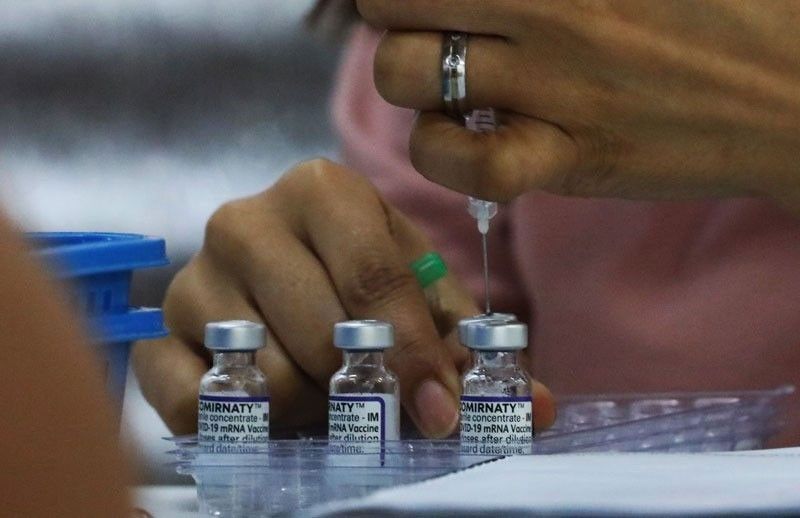390,000 bivalent COVID-19 jabs arriving this month

MANILA, Philippines — The country is expecting delivery of 390,000 doses of bivalent COVID-19 vaccines by the end of the month, Department of Health (DOH) officer-in-charge Maria Rosario Vergeire said yesterday.
At a press briefing yesterday, Vergeire said that this one country, the name withheld for the time being, is going to donate to the Philippines 390,000 doses of bivalent vaccines.
“We have already started with the process and we were able to get emergency use authority from the Food and Drug Administration,” said Vergeire. “We are just finalizing the documents. Hopefully, by the end of May, we will be able to receive this 390,000 doses.”
“We have engaged in a discussion with the government of this particular country and they gave its approval and even the (vaccine) manufacturer also approved to drop this immunity clause, so the clause has been modified that is why we are able to proceed (with the transaction),” she explained.
“What has been keeping us from making the bivalent vaccines available in the country is the search for this legal basis, this requirement coming from the manufacturer for us to sign this indemnification clause and immunity from liability,” Vergeire said.
As to the bivalent vaccine donation from COVAX, Vergeire said: “We haven’t reached a final agreement yet because the first batch to be delivered was put on hold, and so it was given to another country. The COVAX Facility though remains committed to donating bivalent vaccines to the country once we have our legal basis.”
A bivalent vaccine targets both the original strain of the COVID virus and Omicron subvariants.
Vaccine hesitancy
Sen. Bong Go renewed his call for health authorities to address vaccine hesitancy and promote awareness on the importance of immunization following reports that almost half of Filipino children are not being fully immunized against common diseases like measles and polio.
“As per a report, only 57 percent of the target youth nationwide were fully immunized from 2012 to 2021. This is too far from the DOH’s target. You know, this is a disaster waiting to happen,” Go said after the groundbreaking of Bago City Super Health Center in Negros Occidental recently.
In recent reports, the United Nations Children’s Fund (Unicef) cited that trust in giving vaccines to Filipino children dropped by nearly 25 percent or at least 67 million children.
“We must have a whole-of-government approach to solve this issue. I encourage the government to solve the causes of this low vaccination rate,” said Go, chairman of the Senate committee on health and demography.
Recognizing the need for a more robust response to public health crises, Go earlier refiled his twin bills – Senate Bills No. 195 and 196 – to establish the Philippine Center for Disease Control and Prevention, and the Virology Science and Technology Institute of the Philippines.
Rate rising
The percentage of people testing positive for COVID-19 continued to increase in the National Capital Region (NCR) and other provinces across the country, according to the OCTA Research group.
Citing data from the DOH, OCTA fellow Guido David said the seven-day positivity rate – which measures the number of positive results out of total tests conducted – increased to double digits in many provinces.
As of April 29, “high” positivity rates of more than 20 percent were recorded in Camarines Sur (38.7 percent), Rizal (28.5 percent), Cavite (28.1 percent) and Laguna (21.2 percent).
In NCR, the seven-day positivity rate increased from 10.2 percent on April 22 to 17.2 percent on April 29, considered as “moderate” based on OCTA’s assessment.
Other areas with double digit positivity rates included Isabela at 16.7 percent (from 11.7 percent), Negros Occidental at 14.4 percent (from 10.9 percent), Misamis Oriental at 12.9 percent (from 18.1 percent), Cebu at 12.3 percent (from 8.2 percent), Pampanga at 12.1 percent (from 8.3 percent), Benguet at 11.5 percent (from 9.2 percent), Batangas at 11.2 percent (from 5.9 percent) and Bulacan at 10.4 percent (from 7.8 percent).
Below 10 percent, but still considered “moderate,” were Zamboanga del Sur at 9.5 percent (from 5.7 percent), Davao del Sur at 8.6 percent (from 7.5 percent), Pangasinan at 7.5 percent (from 3.8 percent), South Cotabato at 7.2 percent (from 6.2 percent) and Iloilo at 5.5 percent (from 3.5 percent).
The World Health Organization recommends a positivity rate of five percent or below to effectively manage the pandemic.
4,456 new cases
The country has recorded 4,456 new COVID-19 infections from April 24 to 30, the DOH reported in its latest COVID-19 Bulletin.
Meanwhile, the daily average number of new COVID infections is 637, about 42 percent higher than the previous week.
The DOH also said there were 22 patients in severe and critical condition, while no deaths from COVID in the period.
Particularly, last Sunday, the DOH recorded 351 severe and critical COVID patients who sought admission in hospitals. This number is 8.0 percent of the total COVID admissions in the country.
Out of the 2,021 ICU beds intended for COVID patients, 303 (15.0 percent) were occupied while 18.1 percent or 3,157 out of 17,480 non-ICU COVID beds are being used. – Cecille Suerte Felipe, Janvic Mateo
- Latest
- Trending



























